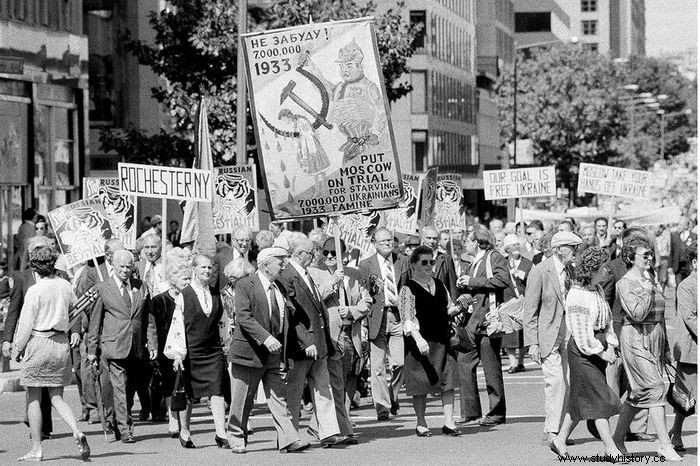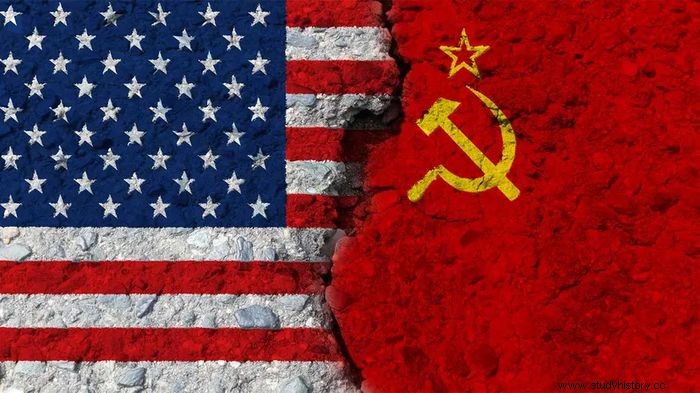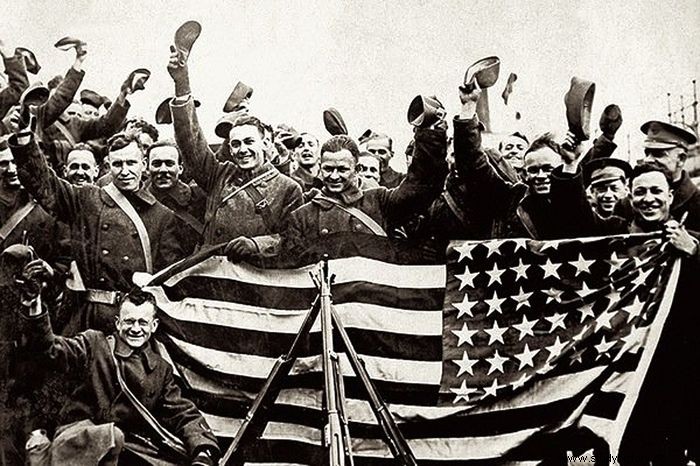As important events fade over time, history must gather all the facts and emotions and present them to future generations. Such an event, possibly the most significant in the twentieth century, has lost relevance in many people's daily lives:the Cold War. The Cold War changed American foreign policy and political ideology, affected the domestic economy and the president, and affected the daily lives of Americans, resulting in expected uniformity and a normal situation. The dissent then increased around the end of the 1950s, and peaked in the late 1960s. The Cold War would continue practically until the fall of the Iron Curtain and the demise of the Soviet Union. The origins of the Cold War go back to the red scarecrow of the United States in the late 1910s. Throughout the 1920s and 1930s, there was widespread suspicion and fear of the Soviet Union, which grew stronger under Joseph Stalin's ruthless government.
Decoding the Cold War

After World War II, the Cold War is a bloated and time of geopolitical tension between the massive United States, the Soviet Union and their respective allies, the Western Bloc and the Eastern Bloc. The open but limited rivalry developed between the United States and the Soviet Union and their respective allies after World War II. The Cold War took place primarily on political, economic and propaganda grounds, with limited use of weapons. In a 1945 article, the English author George Orwell used the term to describe what he thought would be a nuclear battle between "two or three monstrous superstates, each with a weapon capable of exterminating millions of people in a matter of seconds." . Bernard Baruch, an American businessman and presidential adviser, used the term in a speech in Columbia at the State House in South Carolina in 1947.
The term "cold war" was coined as there were no specific large-scale battles directly between the two superpowers. The term was coined, although they sponsored huge regional conflicts known as proxy warriors. After their temporary cooperation and triumph over Nazi Germany in 1945, the struggle revolved around the ideological and geopolitical ambitions of these two nations for worldwide dominance. Apart from the development of nuclear weapons and the conventional military deployment, the struggle for dominance was fought indirectly through psychological warfare, media operations, espionage, far-reaching embargoes, sporting rivalries and technological competitions such as the Space Race.
The beginning of the Cold War

When Nazi Germany surrendered in May 1945, near the end of World War II, the shaky war alliance between the United States and Britain on the one hand, and the Soviet Union on the other, began to disintegrate; by 1948, the Soviets had installed left-wing governments in countries liberated by the Red Army in Eastern Europe. The United States and Britain were concerned about Soviet supremacy in Eastern Europe and the possibility of Communist parties influenced by the Soviet Union gaining power in Western European democracies.
The Soviets, on the other hand, were determined to retain control of Eastern Europe in order to shield themselves from a resurgent German threat, as well as to spread communism throughout the world for ideological reasons. By 1947-48, the Cold War had intensified, with the US Marshall Plan bringing Western Europe under US rule and the Soviets openly installing communist regimes in Eastern Europe.
A rivalry between the superpowers
The Cold War reached its peak in 1948-53. During this time, the Soviets tried but failed to block the western areas of West Berlin (1948-49); The United States and its European allies founded NATO, a unified military command to fight the Soviet presence in Europe (1949). The Soviet Union detonated its first atomic bomb in 1949, breaking the US nuclear bomb monopoly; Chinese Communists on the mainland took power (1949).
Although the longtime Soviet dictator Joseph Stalin died in 1953, the conflict continued. In 1955, the Warsaw Pact, a unified military organization of Soviet bloc countries, was founded, and West Germany joined NATO the same year. From 1958 to 62, the Cold War was at its most intense. In 1962, the Soviet Union secretly began placing missiles on Cuba that could be used to launch nuclear attacks on American cities. It provoked the Cuban Missile Crisis of 1962, which pushed the two countries to the brink of war before an agreement was reached to evacuate the missiles.
Cuban Missile Crisis
The Cuban Missile Crisis showed that neither the United States nor the Soviet Union was willing to use nuclear weapons for fear of retaliation from the other (and thus for mutual nuclear annihilation). As a result, the two superpowers quickly signed the 1963 nuclear test ban agreement, which banned nuclear testing on the ground. However, the crisis cemented the Soviets' decision never to be humiliated by their military inferiority again, and they began building both strategic conventional and strategic forces that the United States was obliged to match for the next 25 years.
During the Cold War, the United States and the Soviet Union avoided direct military conflict in Europe and engaged in combat operations only to prevent the Allies from overthrowing them after they had done so. Thus, the Soviet Union sent troops to East Germany (1953), Hungary (1956), Czechoslovakia (1968) and Afghanistan to maintain communist authority (1979). The United States, for its part, helped to overthrow a left-wing government in Guatemala in 1954, supported a failed invasion of Cuba in 1961, invaded the Dominican Republic (1965) and Grenada (1983), and tried but failed to prevent the communist North. Vietnam from Conquering South Vietnam (1964–75).
Why was NATO created?

The United States was not the only one concerned about Stalin's attempts to expand Soviet power to the west and subjugate other nations. In 1948, the Soviet Union gave its support to a communist coup in Czechoslovakia and launched a blockade of West Berlin, divided into occupation zones controlled by communists in the east and capitalists in the west.
The United States and its allies founded the North Atlantic Treaty Organization, or NATO, as a transatlantic mutual defense alliance to show unity. The United States, Canada, Belgium, Denmark, France, Iceland, Italy, Luxembourg, the Netherlands, Norway, Portugal and the United Kingdom - it was a signatory convention on April 4, 1949. It was a statement that "an armed attack on one or more ... will be an attack on all of them. "
How dangerous did the Cold War come close to nuclear war?
The United States and the Soviet Union ended up in an arms race when there was a confrontation over the Iron Curtain, and invested trillions of dollars in building nuclear arsenals.
At the start of the arms race, the United States had an advantage. But as the Soviet Union developed its nuclear arsenal, the two sides were locked in a battle for "mutually assured destruction," or the belief that if one side struck, the other would retaliate, resulting in catastrophic consequences for both. / P>
Both countries had missile defenses aimed at each other, and the Cuba crisis in 1962 brought the Cold War to the forefront more than any other event. Soviet missile bases and weapons discovered communist Cuba, about 90 miles south of Florida. President John F. Kennedy called for their withdrawal, warning that a strike on American soil would result in an impending nuclear attack on the Soviet Union.
The possibility of nuclear war marked almost two weeks of difficult negotiations. In the end, the Soviet Union agreed to dismantle its weapons installations in exchange for a promise from the United States not to invade Cuba. In addition, the United States agreed to remove nuclear weapons from Turkey behind closed doors; the scheme was not published until 1987.
Despite this, both sides' nuclear arsenals continued to expand exponentially. By the end of the 1980s, the United States had 23,000 39,000 nuclear weapons more than the Soviet Union's XNUMX XNUMX.
Aiming for a new world order

The struggle between the Soviet Union and the American gave way to intricate international relations in the 1960s and 1970s. There was a time when there was no division into two oppositions in the world. The Soviet Union and China suffered a fundamental schism in the 1960s that worsened over the years, destroying the unity of the Communist bloc. Meanwhile, in the 1950s and 1960s, Western Europe and Japan saw rapid economic growth, which reduced their relative disadvantage relative to the United States. Less powerful countries had more leeway to establish their independence, and they often defied superpower forces or lures.
Strategic arm limitation calls
The Strategic Arms Limitation Talks (SALT) led to the SALT I and II agreements of 1972 and 1979. As a result, the two superpowers set limits on their anti-ballistic missiles and strategic missiles capable of carrying nuclear warheads, indicating a de-escalation of tensions in the Cold War. Nevertheless, the two superpowers continued their great military build-up and fought for influence in the third world, which resulted in renewed tensions in the Cold War in the early 1980s.
But during the administration of Soviet leader Mikhail S. Gorbachev in the late 1980s, the Cold War began to break out. He launched an attempt to democratize the Soviet political system by dismantling the dictatorial features of the Soviet regime. As a result, Gorbachev agreed to the fall of communist regimes in the Soviet bloc countries of Eastern Europe in 1989-90. The union of West and East Germany under NATO auspices took place after democratic administrations in East Germany, Poland, Hungary and Czechoslovakia came to power. The Soviets sent approval for it as well.
Meanwhile, Gorbachev's internal reforms had weakened his own Communist Party, allowing the government to pass to Russia and the other Soviet republics. The Soviet Union collapsed in late 1991, leaving 15 newly independent states in its wake, including a Russia led by a freely elected anti-communist president. The Cold War was officially over.
Why the name "Cold War"?
The term "cold war" has existed since the 1930s, when France used the term "Guerre froide" to describe increasingly tense ties between European nations. The British author George Orwell coined the term shortly after the United States dropped the atomic bomb on the sites of Hiroshima and Nagasaki in 1945, in an article assessing the international consequences of the explosion.
The atomic bombs killed over 100,000 XNUMX Japanese. It revealed a destructive force that was so sinister that Orwell predicted that it would deter large countries from fighting openly. This was instead to produce "a state that was invincible and eternally at war with its neighbors." As the seeds of hostility between the former Allies sprouted, Orwell's warning of a "peace that is not peace" became a reality.
How else could the Cold War have happened?
During the Cold War, the United States and the Soviet Union fought several proxy battles around the world. During the Korean War, the Vietnam War, and other armed confrontations, superpowers supported opposing factions or fought directly against communist or capitalist militias. Both sides sponsored revolutions, uprisings and political executions in Latin America, Africa, Asia and the Middle East.
In a 20-year space race, the United States and the Soviet Union competed for scientific supremacy. With the launch of Sputnik-1, the first artificial satellite, in 1957, the Soviet Union took the lead, while the United States was the first to send a man to the moon in 1969. Then, in the mid-1970s, the two countries began working. together on joint missions.
What does the end of the Cold War mean?

The Soviet Union no longer exists, and nuclear arsenals have plummeted thanks to non-proliferation agreements signed by Washington and Moscow in the 1980s and 1990s. In addition, the United States and Russia have worked together on various global challenges in recent decades, including Afghanistan and the fight against terrorism.
However, the Cold War continues to influence modern geopolitics. Both countries have geopolitical rivalries, huge defense budgets and worldwide military outposts. NATO continues to have political power and now has 30 member countries. Former Soviet republics and members of the Warsaw Pact such as Poland and the Baltic states are now part of the alliance, which borders Russia. Russia has seen NATO's enlargement to the east as a threat to its security since the 1990s.
After the Russian invasion of Ukraine in February 2022, tensions between Russia and the West reached a new high. Ukraine had applied to join NATO in 2008, but a new president delayed the idea two years later. As a result, some analysts have compared the current crisis to the start of a new Cold War.
the conclusion
The US presidency changed as a result of the Cold War. Both internal and external pressure affected the development. Internally, Truman's tough stance on Stalin exerted enough pressure on his administration to influence several presidential decisions. To improve their situation, politicians used anti-communist panic to campaign on a strong, right-wing platform. They occasionally began to accuse the current administration of weakness. Due to the Cold War, US foreign policy became one of confinement as the two countries' mutual trust eroded. It was a chess game with the globe map as the board evolved. The US-backed corrupt and anti-democratic governments were friendly to the United States. Meanwhile, the Soviets supported organizations that served their interests.
